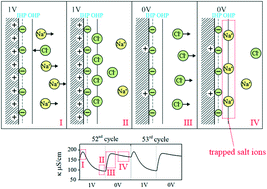Role of metastable-adsorbed charges in the stability degradation of carbon-based electrodes for capacitive deionization†
Abstract
Stability studies are essential to understanding the limitations of capacitive deionization (CDI) technology and to future commercialization efforts. In this work, the effect of trapped salt ions on stability degradation is explored. The extraction results indicate that Na+ and Cl− exist in aged electrodes and are metastably trapped. Accordingly, a schematic illustration based on the classical Gouy–Chapman–Stern (GCS) model is made to present the dynamic movement of ions near degraded electrodes with regard to the inversion effect. Moreover, a two-electrode voltage sweep test (voltage of null conductivity change (Vncc) test) is developed to simultaneously monitor the active voltage window for CDI. This voltage sweep test is conducted along with long-term operation of CDI cells. The results indicate that the active voltage window between the electrodes decreases gradually, with prolonged cycling, or increases immediately, by inverting the applied voltage of the cell. The shift of Vncc and the desalination ability are found to be strongly correlated, regardless of the cycling history of the electrodes. Therefore, the Vncc test can be a practical tool for sensing both the active voltage window and the desalination ability of carbon-based electrodes during prolonged or continuous CDI operations.



 Please wait while we load your content...
Please wait while we load your content...